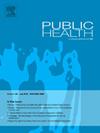不平等的负担:欧洲心血管危险因素的收入相关差异
IF 3.2
3区 医学
Q1 PUBLIC, ENVIRONMENTAL & OCCUPATIONAL HEALTH
引用次数: 0
摘要
目的评估2020年欧洲国家与心血管危险因素相关的社会不平等的国家间差异。研究设计:观察性横断面研究。方法:我们分析了来自31个欧洲国家的欧洲健康访谈调查(EHIS 3)(2018-2020)的数据。以40岁以上的成年人为研究对象,共有248,420名参与者。社会经济地位通过净等值月收入进行评估,分析6个心血管危险因素:血脂异常、糖尿病、高血压、肥胖、吸烟和久坐不动的生活方式。考虑调查权重,计算描述性分析、患病率估计以及泊松回归模型和用于量化各组间健康不平等的相对不平等指数(RII)。结果欧洲所有心血管危险因素的患病率和不公平指数存在显著的地理异质性。收入与这些因素的患病率呈线性剂量-反应关系(糖尿病、高血压和久坐不动的生活方式的患病率最高),揭示了一些正的和反的不平等(偏离预期的社会梯度)。在保加利亚、立陶宛、葡萄牙和罗马尼亚,女性糖尿病患者(RII = 2.265 [95% CI]: 2.427-2.838)与男性糖尿病患者(RII = 1.785 [95% CI]: 1.653-1.928)的性别差异最大,吸烟习惯的性别差异最大(RII<1)。结论:该研究强调了心血管风险因素中与收入相关的显著不平等,低收入人群表现出更高的血脂异常、糖尿病、高血压、肥胖、吸烟和久坐生活方式的患病率。注意到各国的具体差异,有些国家的不平等现象比较严重,而另一些国家的不平等现象不那么明显,甚至相反。这些发现强调需要以公平为导向的医疗服务,以减少心血管疾病负担和解决显著的社会经济差距。本文章由计算机程序翻译,如有差异,请以英文原文为准。
The burden of inequity: Income related disparities in cardiovascular risk factors in Europe
Objectives
To assess intercountry differences in social inequities related to cardiovascular risk factors across European countries in 2020.
Study design
Observational, cross-sectional study.
Methods
We analyzed data from the European Health Interview Survey (EHIS 3) (2018–2020) across 31 European countries. Focusing on adults over 40, with a sample of 248,420 participants. Socioeconomic position was assessed by net equivalised monthly income, analyzing six cardiovascular risk factors: dyslipidemia, diabetes, high blood pressure, obesity, smoking, and sedentary lifestyle. Descriptive analyses, prevalence estimation along with Poisson regression models and relative inequity indexes (RII) for quantification of health inequity among groups were calculated, considering survey weights.
Results
Significant geographical heterogeneity in prevalence and inequity indexes of all cardiovascular risk factors throughout Europe were found. Income presents a linear dose-response relationship with the prevalence of these factors (maximum for Diabetes, High blood pressure and Sedentary lifestyle), revealing some positive and inverse inequities (deviating from expected social gradient). Maximum gender disparity was found for Diabetes in women (RII = 2.265 [95 % CI]: 2.427–2.838) versus Men (RII = 1.785 [95 % CI]: 1.653–1.928) and inverse inequity (RII<1) for smoking habits in Bulgaria, Lithuania, Portugal and Romania.
Conclusions
This study highlighted significant income-related inequities in cardiovascular risk factors, with lower-income individuals exhibiting higher prevalence of dyslipidemia, diabetes, high blood pressure, obesity, smoking, and sedentary lifestyle. Country-specific variations were noted, with some countries experiencing a greater inequity, while others showed less pronounced inequity or even inverse inequalities. These findings highlight the need for equity-oriented healthcare services to reduce cardiovascular disease burden and address significant socioeconomic disparities.
求助全文
通过发布文献求助,成功后即可免费获取论文全文。
去求助
来源期刊

Public Health
医学-公共卫生、环境卫生与职业卫生
CiteScore
7.60
自引率
0.00%
发文量
280
审稿时长
37 days
期刊介绍:
Public Health is an international, multidisciplinary peer-reviewed journal. It publishes original papers, reviews and short reports on all aspects of the science, philosophy, and practice of public health.
 求助内容:
求助内容: 应助结果提醒方式:
应助结果提醒方式:


